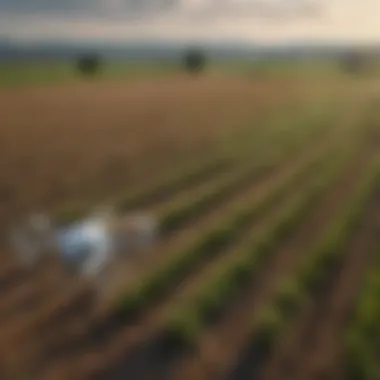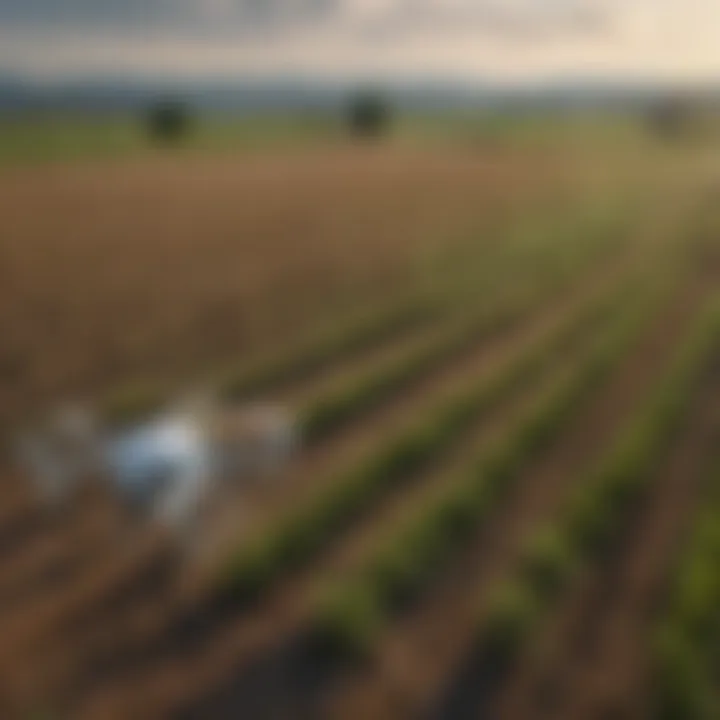Deep Learning Innovations in Drone Technology


Intro
The terrain of technology is under continuous evolution, with innovations reshaping entire industries. One such advancement lies in the integration of deep learning with drone technology. As drones become increasingly prevalent across sectors like agriculture, security, and logistics, understanding how deep learning enhances their capabilities is vital. This discussion provides a deep dive into how deep learning not only augments the operational efficiency of drones but also transforms decision-making processes.
Research Overview
Summary of Key Findings
Recent research indicates that deep learning significantly enhances drone functionality. Models such as convolutional neural networks (CNNs) show profound effectiveness in image recognition tasks that drones often encounter. These advancements empower drones to perform various functions autonomously, ranging from surveillance to agricultural monitoring.
Background and Context
The convergence of deep learning and drone technology is not merely a trend but a paradigm shift. Drones equipped with deep learning capabilities are able to analyze complex data sets in real-time, making them indispensable tools in fields where quick decision-making is crucial. Industries are observing decreased operational costs and improved task accuracy by utilizing these sophisticated systems.
"The integration of deep learning algorithms in drones has opened new possibilities, enabling real-time data analysis and adaptive decision-making."
Methodology
Experimental Design
Researchers typically employ a variety of experimental setups. By simulating real-world scenarios, they assess how drones equipped with deep learning models respond to dynamic environments. These experiments aim to test algorithms across numerous conditions, ensuring robustness and reliability.
Data Collection Techniques
Data collection is fundamental to the advancement of deep learning within drones. Techniques such as aerial imagery capture, Lidar mapping, and sensor data acquisition facilitate a rich data environment. This data is then used for training deep learning models, enhancing their ability to recognize patterns and make informed decisions during flight operations.
Preface to Deep Learning in Drone Technology
Deep learning has emerged as a key player in the advancement of various technologies and applications. In the realm of drones, the integration of deep learning techniques fosters significant enhancements in operational efficiency, decision-making capabilities, and overall performance. This article provides insights into how deep learning massively upgrades drone performance through intelligent data processing and analysis.
Understanding Deep Learning
Deep learning is a subset of artificial intelligence that leverages multi-layered neural networks to process vast amounts of data. Unlike traditional machine learning, which may require explicit programming, deep learning systems learn patterns from data directly. This adaptive learning process allows for improvements in tasks such as image recognition, sensory perception, and navigation, making it a valuable asset for drone technology.
In practical terms, deep learning techniques enable a drone to recognize complex patterns in real time. This could include distinguishing between various terrains, recognizing obstacles, and even interpreting weather conditions. Understanding deep learning is crucial, as it forms the foundation for the autonomous features we see in modern drones.
Overview of Drone Technology
Drones, also known as unmanned aerial vehicles (UAVs), have evolved from simple remote-controlled toys to sophisticated aircraft capable of performing a myriad of tasks. They are used across multiple industries, including agriculture, disaster management, and logistics. Equipped with sensors and cameras, drones impart high levels of data fidelity and operational flexibility. The core functions of drones involve capturing data, processing it, and transmitting it to users for analysis and action.
The advancements in drone technology are not just technical; they also raise important questions about usage, safety, and regulations. As drones become more prevalent, understanding their technology and capabilities is essential for maximizing their potential and addressing associated challenges.
Significance of Integrating Deep Learning with Drones
Integrating deep learning with drone technology is significant for several reasons. Firstly, it enhances the drone's ability to process information in real-time. This integration allows drones to autonomously adjust their paths and make critical decisions without human intervention. For example, during search and rescue missions, drones powered by deep learning can navigate complex environments and identify targets more effectively.
Moreover, deep learning contributes to improved safety. Drones can analyze their surroundings better and prevent collisions with obstacles or other aircraft. Additionally, the ability to analyze vast datasets allows for more precise analytics and decision-making. Whether in surveying land for agriculture or mapping disaster areas, drones can proffer detailed insights that were previously unattainable at such scales.
In summary, the combination of deep learning and drone technology heralds a new era of capabilities and applications. The continuous evolution of this integration is set to redefine industries, drive innovations, and establish new standards across numerous fields.
"Deep learning’s ability to process data efficiently sets the stage for advancements in surveillance, agriculture, and disaster response services, changing how we perceive drone capabilities." - Industry Expert
Understanding these dynamics is essential for students, researchers, and professionals aiming to navigate the future landscape of drone technology.
Core Deep Learning Algorithms for Drones


Understanding the core deep learning algorithms is essential when examining the advancements in drone technology. These algorithms help drones to process data efficiently, recognize patterns, and make decisions autonomously. By leveraging the strengths of these algorithms, developers can enhance drone capabilities, leading to better performance across various applications.
With deep learning, drones can analyze and interpret vast amounts of data collected from their surroundings. This leads to improvements in operational efficiency, precision, and overall decision-making processes. In this section, we will explore three important deep learning algorithms that are particularly useful for drones: Convolutional Neural Networks (CNNs), Recurrent Neural Networks (RNNs), and Generative Adversarial Networks (GANs). Each of these algorithms offers unique benefits and addresses specific challenges in drone operations.
Convolutional Neural Networks (CNNs)
Convolutional Neural Networks are a fundamental model often used in computer vision tasks. In the context of drones, CNNs excel at image classification and object detection. This capability is vital for scenarios where drones need to identify obstacles or targets based on visual data.
CNNs operate through a series of layers that apply filters to input images. This allows the network to learn features at various levels of abstraction, from basic lines and curves to more complex shapes. For instance, in aerial surveillance, a drone utilizing a CNN can effectively distinguish between different types of vehicles or recognize human activities.
The implications of CNNs in drone operations are significant. They enable real-time processing of video feeds, making drones capable of responding swiftly to changing environments. Applications in agriculture, for example, include crop health monitoring, where CNNs analyze images to detect signs of diseases or nutrient deficiencies in crops.
Recurrent Neural Networks (RNNs)
Recurrent Neural Networks are tailored for sequential data, making them suitable for tasks involving time series or contextual dependencies. For drones, RNNs can be instrumental in analyzing data from sensors over time, such as tracking movements in search and rescue missions or predicting flight paths based on historical data.
Unlike CNNs, RNNs maintain a memory of past inputs, allowing them to capture temporal dynamics. This characteristic is particularly valuable in scenarios where drones need to assess changing conditions or make decisions based on previous observations.
In practical applications, RNNs may enhance a drone's ability to navigate complex environments by predicting potential obstacles based on past movements. This predictive capability results in safer and more efficient operations, especially in dynamic settings like urban landscapes or disaster zones.
Generative Adversarial Networks (GANs)
Generative Adversarial Networks represent a unique class of deep learning models that consist of two competing networks: a generator and a discriminator. This setup enables GANs to produce new data that mimics real-world data. In drone technology, GANs can be particularly useful for simulation and training purposes.
The generator creates synthetic data that resembles the real data used in training, while the discriminator attempts to distinguish between real and generated data. Through this adversarial process, GANs can help create diverse training datasets, which can lead to improved model performance in real-world applications.
For drones, GANs can generate high-quality images for training CNNs or augment existing datasets to account for rare scenarios that may occur during flight. This is critical in developing robust and reliable drone systems, as they can adapt better to varied conditions during actual operations.
In summary, the incorporation of Convolutional Neural Networks, Recurrent Neural Networks, and Generative Adversarial Networks is crucial for enhancing drone technology. These algorithms enable drones to process information more effectively, leading to innovations across industries such as agriculture, surveillance, and emergency response.
Data Collection and Processing for Drones
Data collection and processing form the backbone of operational efficiency in drone technology, especially when integrated with deep learning. The ability to gather vast amounts of data from various sources and process it effectively is paramount for enhancing decision-making and optimizing flight operations. Drones equipped with advanced sensors and imaging technologies can collect real-time data that is crucial for analysis and action.
This section discusses the key aspects of data acquisition and processing, emphasizing their importance in harnessing the full potential of deep learning.
Data Acquisition Technologies
Data acquisition technologies encompass a wide range of sensors and tools that drones utilize to collect information in various environments. This can include visual data from cameras, thermal imaging, LiDAR, or other specialized sensors designed for specific applications.
- Cameras: High-resolution cameras enable drones to capture detailed images and videos, vital for applications in agriculture, surveillance, and mapping.
- LiDAR: This technology uses laser pulses to measure distances, creating accurate 3D maps of terrain and objects. It is widely used in topographical surveys and forestry management.
- Multispectral Sensors: These sensors capture data at different wavelengths, allowing for more detailed analysis in precision farming, as different crops reflect light uniquely.
Each drone's operational context dictates which data acquisition technologies are most suitable, influencing not only the kind of data collected but also how it is processed post-collection.
Effective data acquisition ensures that raw data is rich and relevant, providing the foundation required for robust analytical models.
Preprocessing Data for Training Models
Once data is acquired, preprocessing is essential to convert that data into a usable format for deep learning models. This stage involves multiple steps that are critical for ensuring accuracy and reliability in the subsequent analysis.
Key preprocessing steps include:
- Data Cleansing: Removing inconsistencies and errors in the dataset helps improve the quality of input data.
- Normalization: Adjusting data values to a common scale allows models to learn more effectively without being biased toward larger values.
- Data Augmentation: This involves creating variations of the existing data to increase the volume of training samples. For instance, rotating images or adjusting brightness can simulate various conditions a drone may encounter in real scenarios.
Proper preprocessing is vital for successful training of deep learning models. It enhances model accuracy and prevents issues related to overfitting or underfitting.


Applications of Deep Learning in Drones
The integration of deep learning in drone technology marks a significant leap in their capabilities across various sectors. Understanding these applications is essential because they illustrate how advanced algorithms enhance operational efficiency, autonomy, and decision-making. As the demand for more advanced drone functionalities grows, the applications of deep learning offer potential solutions that can redefine traditional operational frameworks. The potential uses are vast, ranging from optimizing agricultural practices to enhancing security surveillance.
Agriculture and Precision Farming
Deep learning plays a transformative role in agriculture and precision farming. Farmers can utilize drones equipped with cameras and sensors to monitor crop health in real-time. Through remote sensing, drones collect data that depicts various factors, such as plant health, moisture levels, and nutrient deficiencies. By processing this data through convolutional neural networks, farmers can receive actionable insights, allowing for precise irrigation and optimized pesticide application. This use of technology not only improves crop yields but also promotes sustainable farming practices.
Benefits include:
- Reduced Costs: Less manual labor and lower meterial use.
- Increased Yields: Data-driven decision-making boosts production efficiency.
- Sustainability: Minimizing chemical usage aids in environmental conservation.
Search and Rescue Operations
In emergency situations, drones equipped with deep learning capabilities can significantly improve search and rescue operations. By employing real-time image recognition, drones can identify victims quickly in challenging terrains. Using algorithms, drones can process thermal imagery to detect heat signatures, which is critical for locating individuals lost in remote areas. Moreover, the autonomous navigation features allow drones to cover large areas efficiently.
Key advantages include:
- Speed: Rapid deployment leads to quicker responses.
- Precision: Enhanced detection accuracy increases the chances of successful rescues.
- Accessibility: Drones can reach areas that may be hazardous or difficult for human teams to access.
Delivery Services
The advent of deep learning has revolutionized the logistics sector, particularly in delivery services. Companies like Amazon are experimenting with drone delivery, which has the potential to streamline last-mile logistics. Drones powered by deep learning can optimize routes using real-time traffic data, resulting in faster deliveries. Additionally, deep learning enhances safety features; drones can identify obstacles and dynamically adjust flight paths.
Considerations for implementation involve:
- Regulatory Compliance: Navigating air traffic regulations is critical for safe operation.
- Safety Protocols: Ensuring drones can respond to potential hazards effectively.
- Consumer Acceptance: Building trust and awareness about drone deliveries.
Surveillance and Security
Drones have become increasingly prominent in surveillance and security applications. Organizations rely on drones for monitoring large areas and maintaining security in high-risk zones. By employing advanced deep learning algorithms, these drones can analyze video feeds, detect unusual behavior, and differentiate between various types of movement. This capability allows for proactive security measures and more effective monitoring.
The benefits of deep learning in surveillance are notable:
- Real-time Analysis: Immediate threat detection and reporting capabilities.
- Cost-effectiveness: Reduces the need for extensive manpower in security monitoring.
- Detailed Surveillance: Collects comprehensive data, which improves situational awareness.
Deep learning provides the analytical backbone that enables drones to operate effectively across multiple sectors, reshaping traditional practices and improving outcomes in each field.
Challenges in Implementing Deep Learning for Drones
The integration of deep learning with drone technology presents numerous advantages, yet there are significant challenges that require careful consideration. Understanding these challenges is crucial for researchers, developers, and industry professionals aiming to harness the full potential of this technology. Addressing these issues can lead to enhanced performance, better compliance with regulations, and improved data security, all of which are vital for recent advancements in drone applications.
Technical Limitations
Technical limitations are often the most immediate challenge when implementing deep learning in drones. These limitations can include issues related to hardware capabilities, algorithm efficiency, and processing power. For instance, drone hardware may be constrained in terms of battery life, processing capacity, and onboard storage. This can hinder the ability to run complex deep learning algorithms in real time.
Moreover, high-performance models may require extensive computational resources, which might be impractical for small drones. Researchers and developers must work on optimizing models to ensure they can fit within these constraints.
Common technical issues include:
- Latency: Delays in processing data can impact decision-making.
- Data Quality: Poor-quality training data leads to bad model performance.
- Overfitting: Overly complex models may not generalize well to new data.
Finding solutions to these technical obstacles is essential for advancing the integration of deep learning in drones, making it more feasible and effective for various applications.
Regulatory and Privacy Concerns


Regulatory frameworks surrounding drone technology are rapidly evolving but are often lagging behind advancements in deep learning. Governments across the globe are still formulating comprehensive regulations, and this can create uncertainty for organizations deploying drone technology integrated with deep learning.
Regulatory concerns include:
- Flight Restrictions: In many areas, drones face strict guidelines on where and when they can fly.
- Data Usage Policies: There is the need for clear guidelines about how data is collected, stored, and used to protect individual privacy.
- Liability Issues: Questions about responsibility in the event of accidents or data breaches can complicate deployment.
Additionally, privacy is a significant issue. Drones equipped with deep learning capabilities can gather vast amounts of sensitive data, heightening the risk of intruding on people's privacy. Organizations must navigate these legal landscapes carefully to avoid fines and protect user trust.
Data Security Issues
Data security is another critical challenge faced by organizations integrating deep learning into their drone technology. The sensitivity of the information collected by drones can make them attractive targets for cyberattacks. Ensuring that data is secure from unauthorized access, manipulation, or theft requires dedicated efforts and resources.
Key data security challenges include:
- Secure Data Transmission: Data must be securely transmitted from the drone to ground stations to prevent interception.
- Data Storage Security: Stored data must be protected from breaches to maintain confidentiality and integrity.
- Vulnerability Assessments: Regular evaluations are required to identify and mitigate potential vulnerabilities in the drone's software and communication systems.
Future Trends in Deep Learning and Drone Technology
The future of deep learning in drone technology promises to shape numerous industries profoundly. As the world embraces greater efficiency and adaptability in operations, integrating advanced artificial intelligence systems with drone technology is crucial. This section delves into several aspects of these future trends, examining advancements and implications for society, technology, and the economy.
Advancements in AI and Machine Learning
Innovations in AI and machine learning are at the forefront of the evolution of drone capabilities. The developments in neural networks, particularly in areas like reinforcement learning, enable drones to learn from their environments and make real-time decisions more effectively. For instance, drones equipped with improved AI can navigate complex terrains autonomously and optimize flight paths, which enhances their operational efficiency. These advancements lead to:
- Better image recognition: Enhanced algorithms allow drones to identify objects and obstacles more accurately.
- Predictive analytics: Drones can analyze data patterns and make predictions on equipment needs or environmental changes.
- Operational adaptability: Drones can adjust their behavior based on learning from past experiences, reducing errors over time.
Collaborative Drones and Swarm Robotics
The concept of collaborative drones and swarm robotics represents an exciting front in deep learning applications. Drones can work together in coordination for various tasks, such as logistics, surveying, and search operations. By utilizing swarm intelligence, multiple drones can execute complex operations with remarkable efficiency. This can lead to:
- Increased redundancy: If one drone fails, others can continue the mission with minimal disruption.
- Enhanced coverage areas: Swarms can cover larger regions quickly, which is essential in search-and-rescue missions.
- Resource optimization: Drones can share data amongst themselves, allowing them to work in tandem, thus reducing energy consumption.
Enhanced Autonomous Capabilities
The next generation of drones is set to feature significantly improved autonomous capabilities through deep learning technologies. These capabilities will transform numerous sectors by enabling drones to operate with minimal human intervention. Enhanced autonomy provides the potential for:
- Greater safety: Autonomous drones can perform tasks in dangerous environments, such as disaster areas.
- Cost savings: Minimizing human involvement in operational processes reduces associated labor costs.
- Scalability: Businesses can deploy fleets of drones to tackle large operations efficiently, scaling to meet demand quickly.
"The real value of drones lies in their ability to operate autonomously, covering vast areas and providing insights in real time."
As deep learning continues to advance, the integration of AI technologies and drone systems will provide innovative solutions to complex challenges. The trajectory of drone technology is now poised for an exciting future, promising to enhance capabilities across various domains.
Epilogue
The integration of deep learning into drone technology marks a significant milestone in both fields. This synergy not only enhances the operational capabilities of drones but also fundamentally transforms their application across various sectors. The insights gained from exploring this integration help underscore the importance of continued investment and research in these areas.
Summary of Key Insights
Many key points have emerged from the examination of deep learning advancements within drone technology. Firstly, deep learning algorithms, such as convolutional neural networks, have vastly improved image recognition, enabling drones to efficiently analyze and interpret visual data. Secondly, the ability to process vast amounts of data has allowed for better decision-making and autonomy in drone operations. In addition, the applications of deep learning in drones span multiple industries ranging from agriculture to logistics, highlighting its versatile nature.
Some important insights include:
- Enhanced object detection and classification with CNNs.
- Improved prediction capabilities through RNNs, useful for time-sensitive missions.
- The role of GANs in generating training data for better model accuracy.
The Future of Deep Learning Drones
Looking ahead, the future of deep learning technology within drones appears promising. Emerging trends such as collaborative drones and advancements in swarm robotics suggest that these units will not function independently but will work in unison to accomplish larger tasks with greater efficiency.
Additionally, as machine learning continues to evolve, drones will possess enhanced capabilities for autonomous navigation. This development will lead to broader applications, including urban planning, disaster management, and enhanced security measures.
"The convergence of deep learning and drone technology is not just about sophistication; it is about redefining capabilities and possibilities in uncharted territories."
Moreover, ongoing improvements in data processing power and software algorithms will likely drive more sophisticated applications. These technologies aim not simply to optimize drone performance but to revolutionize how we perceive and utilize aerial technology in everyday life.
The pathway forward demands careful consideration of ethical, regulatory, and technical challenges. With continuous research and collaborative efforts from various stakeholders, the future impact of deep learning in drones will likely redefine multiple industries.







